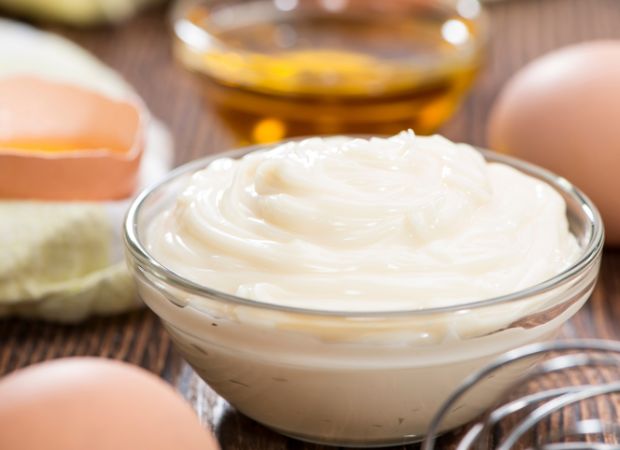Welcome to our new article series, where we delve into the world of substitutions in cooking and baking.
Whether you’re looking to accommodate dietary restrictions, experiment with new flavours, or simply make use of what you have on hand, this series aims to be your guide to innovative cooking and baking at home.
Why substitutions matter
The ability to substitute ingredients is a valuable skill. It empowers home cooks to adapt recipes with relative ease. Moreover, substitutions can spark creativity, encouraging experimentation and innovation in the kitchen.
Mayonnaise
To kick off our series, we’re diving headfirst into your favourite jar of mayonnaise! While traditionally used as a condiment or spread, mayonnaise is far more versatile than you might think.
While mayonnaise can work well in many types of recipes, it is important to consider the overall flavour profile and texture of the dish. In savoury recipes or recipes with delicate flavours, the taste of mayonnaise may be more pronounced. Additionally, mayonnaise may not be suitable for recipes that require a crisp or flaky texture, such as certain types of pastries or cookies. As always, it’s a good idea to experiment with small batches first to gauge the impact of mayonnaise on the final result.
RECIPE: DIY homemade mayonnaise in under 1 minute
What to expect
All things mayo and more! We will be looking at all the various ways to incorporate mayonnaise into both home baking and cooking, highlighting its role as a substitute for eggs, oil, butter, and more.
Plus, we will aim to provide practical tips, recipe ideas, and creative insights to inspire you to experiment with this humble yet versatile ingredient.
The science behind mayonnaise substitutions
At its core, mayonnaise is an emulsion – typically a mixture of oil, egg yolk, and an acidic ingredient such as vinegar or lemon juice. This unique combination of ingredients gives mayonnaise its creamy texture and ability to bind and stabilise other ingredients.
When used as a substitute in recipes, mayonnaise acts as a stand-in for eggs, oil, and even butter, providing moisture, richness, and structure to baked goods and savoury dishes alike.
Mayo as a substitute in baking
Eggs: Replace each egg in the recipe with about 1/4 cup of mayonnaise. Mayonnaise adds moisture and helps bind ingredients together, similar to eggs. This substitution works well in cakes, muffins, quick breads, and even some cookie recipes.
RECIPE: Decadent chocolate mayonnaise cake
Oil: Substitute mayonnaise measure for measure for the oil called for in the recipe. This substitution can result in baked goods that are moister and richer in flavour. It works well in cakes, brownies, and quick breads.
Butter: Replace butter measure for measure with mayonnaise in recipes like cakes, muffins, and quick breads. Mayonnaise adds moisture and richness to baked goods, similar to butter.
Vegan baking: Vegan mayonnaise can be particularly useful in vegan baking as it can replace both eggs and butter. When baking vegan cakes, cookies, or muffins, substitute mayonnaise for both eggs and butter according to the guidelines above.
Moisture and flavour enhancement: In addition to replacing specific ingredients, mayonnaise can also be added to baked goods to enhance moisture and flavour. For example, add a tablespoon or two of mayonnaise to cake or muffin batter to make it extra moist and tender. It can also add a subtle tangy flavour to the finished product.
Mayo as a substitute when cooking
Sautéing: While mayonnaise may not be a direct substitute for oil in high-heat cooking methods, it can be used as a flavoursome fat for sautéing veggies over a medium heat.
RECIPE: Crispy cheesy chicken quesadillas
Coating: Mayonnaise can be used to coat chicken, pork or fish before breading and baking or pan-frying. Not only will this help the breading to adhere to the chicken, pork or fish but it will add a unique flavour pop. Mayonnaise can also be used as a fat to coat chicken before roasting.
RECIPES: Apricot chicken or spatchcock chicken
Binding: Mayonnaise can be used as a binder for meatballs and fishcakes. Swap out the egg for ¼ cup of mayonnaise or simply add in 1 tsp of mayonnaise if your meatballs are struggling to bind properly.
Grilling or braaing: Mayonnaise can be used as a coating for grilling or braaing meats and vegetables. It adds flavour and helps prevent sticking.
Marinades: Incorporate mayonnaise into all your favourite marinades. Its creamy texture helps the marinade adhere to the food and keeps it moist during cooking.
Other ideas
Dips and spreads: Mayonnaise can be used as a base for homemade dips and spreads. Mix it with herbs, spices, mustard, or other flavourings to create a variety of savoury dips for vegetables, crackers, or chips.
Salad dressings: Use mayonnaise as the base for creamy salad dressings. Thin it out with vinegar, lemon juice, or buttermilk and add seasonings to taste.
RECIPE: Crunchy fresh Caesar salad with trout
Sandwiches and wraps: Substitute mayonnaise for butter or oil when making grilled sandwiches or wraps. It adds flavour and helps achieve a golden crust on the bread.

